|
|
|
Sort Order |
|
|
|
Items / Page
|
|
|
|
|
|
|
| Srl | Item |
| 1 |
ID:
144058


|
|
|
|
|
| Summary/Abstract |
Is the relatively long peace of Northeast Asia a result of crisis stability or general stability? The article introduces two stability concepts – crisis and general stability. Crisis stability occurs when both sides in military crisis are so secure due to its military capability and are able to wait out a surprise attack fully confident that it would be able to respond with a punishing counter attack. On the other hand, general stability prevails when two powers greatly prefer peace even to a victorious war whether crisis stability exists or not, simply because war has become inconceivable as a means of solving any political disagreements and conflicts. While crisis stability entails delicate balance of military power from the deterrence literature of security studies, general stability bases its logic of inquiry on constructivism where the idea of war aversion – categorically rejecting war as a means to end conflicts – becomes the prevailing norm. Therefore, this article empirically examines how Northeast Asia has sustained its peace through crisis stability and presents a new trend toward general stability.
|
|
|
|
|
|
|
|
|
|
|
|
|
|
|
|
| 2 |
ID:
143682
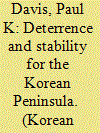

|
|
|
|
|
| Summary/Abstract |
Most trends on the Korean Peninsula favor South Korea, but North Korea’s nuclear program is a great concern, as is the possibility that the North will become desperate at some point because of negative trends. Although unlikely, war—even limited nuclear war—is imaginable in the years ahead, perhaps with winners and losers. This poses challenges for strategic planning. RAND and KIDA have been conducting a collaborative research addressing this issue and this paper is the output of the first year’s research. The first section of this paper reviews and extends strategic theory and lessons from the Cold War by drawing on classic papers and more recent literature, the principal author’s experiences with U.S. strategic planning, recently declassified materials, history, and psychological research. This is followed by a section that outlines the challenges for deterrence salient to Korea today, particularly ways in which deterrence could fail, using historical cases. The final section discusses implications for Korea, highlighting the need to think through how South Korea should consider its new military capabilities and the need to strengthen U.S. extended deterrence. Complacency regarding both matters would be dangerous. Deterrence could fail for such reasons as misperceptions, misunderstanding the adversary, other aspects of limited rationality, and accidents. Further, the challenges for extended deterrence are much greater than earlier, as are those in achieving balance in planning.
|
|
|
|
|
|
|
|
|
|
|
|
|
|
|
|
| 3 |
ID:
167672
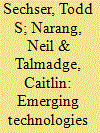

|
|
|
|
|
| Summary/Abstract |
Recent commentary has sounded the alarm about the effects of emerging technologies on strategic stability, yet the topic has received relatively little systematic scholarly attention. Will emerging technologies such as cyber, autonomous weapons, additive manufacturing, hypersonic vehicles, and remote sensing make the world more dangerous? Or is pessimism unwarranted? In this volume, we leverage international relations scholarship, historical data, and a variety of methodological approaches to discern the future implications of new technologies for international security. The findings suggest that new technologies can have multiple, conditional, and even contradictory effects on different aspects of strategic stability, and raise a host of important questions for future research.
|
|
|
|
|
|
|
|
|
|
|
|
|
|
|
|
| 4 |
ID:
157826
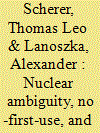

|
|
|
|
|
| Summary/Abstract |
The United States has long embraced calculated ambiguity over the conditions under which it might use nuclear weapons against adversaries, a trend that President Donald J. Trump has continued. This ambiguity could unsettle some observers, especially those who believe that the United States should declare a no-first-use (NFU) policy such that it would not be the first state to introduce nuclear weapons in either a crisis or an armed conflict. NFU advocates identify three potential pathways whereby a more ambiguous posture can lead to increased danger: downward spiral, accidental war, and use-it-or-lose-it. For evidence, they invoke Saddam Hussein’s risk-accepting decision to pre-delegate chemical-weapons use following US nuclear threats in the 1991 Gulf War. In analyzing the reasoning and evidence of these arguments, we argue that the alleged benefits of NFU may be overstated, at least for crisis stability in asymmetric crises, defined by one side’s overwhelming conventional military superiority. Each of the three foregoing pathways is logically inconsistent and the empirical case is misinterpreted. Nuclear ambiguity may not be so dangerous as NFU advocates claim.
|
|
|
|
|
|
|
|
|
|
|
|
|
|
|
|
| 5 |
ID:
125253
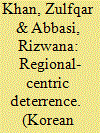

|
|
|
|
|
| Publication |
2013.
|
| Summary/Abstract |
It is generally believed that a stable nuclear deterrence averts wars between nuclear adversaries, and makes peace secure. This conceptual argument has merit in terms of the prevention of all-out war; but it does not fully address the need to prevent the outbreak of a limited war between two nuclear weapon states. India and Pakistan have already fought one limited war, Kargil, in a nuclear environment. These two relatively new nuclear weapon states rely on nuclear deterrence to address the external threats. While frequently occurring conflicts demonstrate this, a recurrence of limited war cannot be ruled out in this crisis-ridden region, which would be fraught with significant dangers of escalation. Using a qualitative research approach and deploying a structural deterrence theory as a conceptual guiding tool, this paper investigates the nuclear future of the region, including the prospects of war, conflict termination strategy, escalation control, escalation dominance mechanisms, and finally suggests some pertinent lessons for crisis stability.
|
|
|
|
|
|
|
|
|
|
|
|
|
|
|
|
| 6 |
ID:
188935


|
|
|
|
|
| Summary/Abstract |
In contrast to the pervasive confidence that the development of nuclear weapons ensures peace and stability by making wars too expensive to fight for, South Asian strategic stability has drifted into nasty security competition through arms race with an episodical crisis that continues at the sub-conventional level. Deterrence studies that were relegated to the bins of history soon after the end of the Cold War received a renewed interest of scholars on the subject since the demonstration of deterrent capabilities by South Asian rivals in 1998. A new wave of deterrence studies has developed in the current multipolar world with some scholars adopting Cold War models of analysis in the contemporary realms of South Asia, whereas other are attempting new analytical approaches. This article aims to offer a fresh look at how to provide a clear concept of strategic stability, how strategic stability is applicable in contemporary South Asia and what the recent crisis between India and Pakistan being interwoven with terrorism tells us about crisis stability between the two countries under the shadows of nuclear weapons.
|
|
|
|
|
|
|
|
|
|
|
|
|
|
|
|
| 7 |
ID:
001721
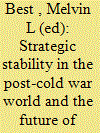

|
|
|
|
|
| Publication |
Dordrecht, Kluwer Academic ., 1995.
|
| Description |
v.3 (xx,330p.)
|
| Standard Number |
0792338057
|
|
|
|
|
|
|
|
|
|
|
|
Copies: C:1/I:0,R:0,Q:0
Circulation
| Accession# | Call# | Current Location | Status | Policy | Location |
| 041151 | 355.825119/BES 041151 | Main | On Shelf | General | |
|
|
|
|
| 8 |
ID:
167674


|
|
|
|
|
| Summary/Abstract |
While the applications of artificial intelligence (AI) for militaries are broad, lethal autonomous weapon systems (LAWS) represent one possible usage of narrow AI by militaries. Research and development on LAWS by major powers, middle powers and non-state actors makes exploring the consequences for the security environment a crucial task. This article draws on classic research in security studies and examples from military history to assess the potential development and deployment of LAWS, as well as how they could influence arms races, the stability of deterrence, including strategic stability, the risk of crisis instability and wartime escalation. It focuses on these questions through the lens of two characteristics of LAWS: the potential for increased operational speed and the potential for decreased human control over battlefield choices. It also examines how these issues interact with the large uncertainty parameter associated with potential AI-based military capabilities at present, both in terms of the range of the possible and the opacity of their programming.
|
|
|
|
|
|
|
|
|
|
|
|
|
|
|
|
|
|
|
|
|